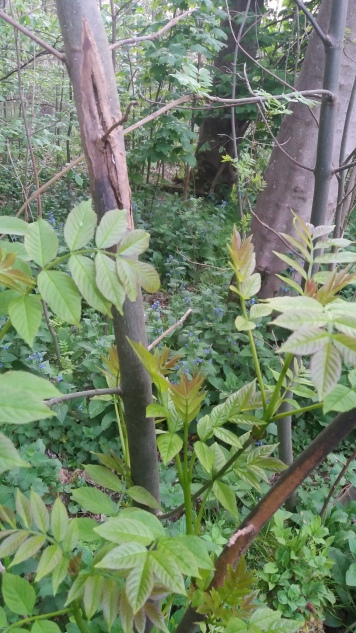May 10th
Wandering through the woods in early May, it would be a simple assumption to make that all is well with the world, and that spring is now unfolding furiously, just as it should, just as it always does. The understorey is becoming dense and complex, flowering plants, ferns and moss all competing for space, and feeding off a rich diet of accumulated organic matter. The canopy overhead is starting to colour itself in with new leaves, and soon the sky will only be visible as pinpricks between them, shifting at the whim of the wind.
But if you look a little closer – and I’m always trying to – you’ll see that in certain places, something is going awry. The picture is not as healthy as it appears on the first, cursory inspection.
The Ash (Fraxinus excelsior) is a stalwart of Britain’s woodlands, as well as our municipal parks, gardens and urban spaces. The bark of its new growth is a distinctive olive-green, its hard black buds bursting in the spring to form fronds of multiple leaf-lets. It can grow to 35 metres and live for 400 years. The tree and its timber have been part of life and folklore for centuries, evidenced by the regularity with which it appears in place names.

Young ash tree showing typical signs of the disease – discoloured stems and branch lesions
Since 2010, the fungal disease known as Chalara or Ash Dieback has been infecting Britain’s ash population. It may have arrived as wind-blown spores, or via saplings imported from mainland Europe. There is no cure for the disease. Common symptoms include discolouration of the bark, blotches on the leaves, and lens- or diamond-shaped lesions on branches and trunks. In Denmark, 90% of trees are reckoned to be affected, and the most pessimistic opinions predict the eventual disappearance of the ash from most of Europe.
I can’t tell you when Ash Die-back reached these parts. I can tell you that this is the first year I’ve noticed it in these woods. I’m sure it has been here longer. And the speed with which it has taken a hold – particularly amongst young saplings – is astonishing.
Ash is not the most well-represented species in these woods – it is easily outnumbered by sycamore and Scots pine. But it is one of the most prolific species when it comes to regeneration. In certain parts of the woods – usually where a mature parent tree is close by – ash seedlings reach skywards in spectacular numbers. Not all are destined to survive to maturity, of course, but in their first year, they can grow to human height and beyond.
Now you wonder whether any of them will survive at all.
And what would that feel like – to have such an emblematic species disappear almost entirely from the landscape? No doubt another opportunist tree species would fill in the gaps left behind, the biosphere never being a sentimentalist. The woods would not become full of holes.
I have no great knowledge about trees, and the diseases that afflict them – or how they might or might not be cured. Personally, I feel a tremendous sense of helplessness, like all I can really do is walk through the woods and try to enjoy the fact that these trees are here, for now at least.